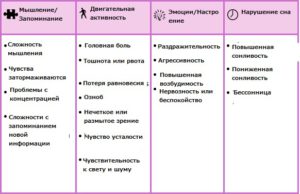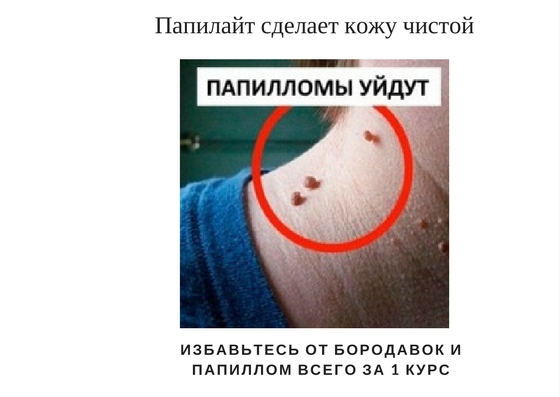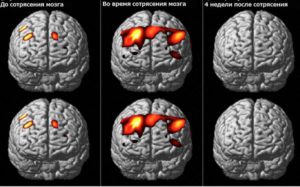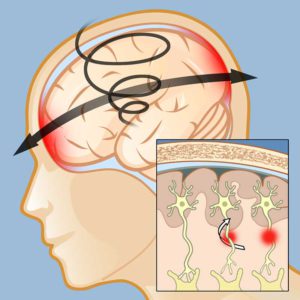Brain fluctuations in TBI
Concussion in children is a mild type of traumatic brain injury (TBI), which accounts for approximately 85–90% of all types of TBI.
Besides mild TBIs, TBIs are classified as moderate or severe.
A moderate TBI is a contusion of the brain, and a severe TBI is a hematoma of the brain, etc.
As for the prevalence of head concussion in children, it is as follows:
In children under one year old, this diagnosis is diagnosed in 25% of cases of the total mass of injured, 2 years - 5 years - 8% of cases, from 6 to 7 years - 20%, school age (8-12 years) - 45%. The remaining 2% are for very tiny children, usually in the first months of life.
It is not so difficult to understand what exactly led to a concussion, but different ages have their own characteristics.
So, in children under 1 year old, the cause is a fall from a height, and as a rule, it is either a sofa, bed or changing table, or (even worse) from the height of the parent's arms. In addition, a shaking of the head in an infant can be triggered by too intense motion sickness, before bedtime.
After the child begins to walk, about a year old, impacts on any objects (walls, corners, etc.) can lead to TBI, since the baby is still uncertainly on his legs. In the period from a year to 2 years, parents with horror will pay attention to the child's interest in climbing conditionally high surfaces, falling from which will not lead to anything good.
It is worth remembering that older age also harbors certain problems, so a child from 2 to 3 years old already quite independently moves around the apartment and is not always under the supervision of parents, but that the baby has hit mom or dad can only find out by crying ... But it happens that a young researcher withstands the blows of fate suffered with honor and does not cry out, only signs of a concussion in a child can help in identifying the problem.
A concussion in adolescents in general is a special case, since at such an adult age, children do not attach serious importance to injuries, considering it a sign of bad taste to seek help from their parents. What to do and how to find out if a child has a concussion? By external manifestations and directly from the victim himself, who already knows how to express thoughts and is able to explain the nature and circumstances of the injury.
How to understand that a baby has a TBI
As noted earlier, TBI or concussion in children has three forms of severity, each with specific features. And in order to understand whether there is a concussion, you need to have a little idea about them. 
With this type of injury, it is more difficult to understand what happened than with a severe form, since the symptoms are not so bright. So how do you identify a concussion? The first signs of a concussion are dizziness (which the baby will not be able to tell about, since the phenomenon is quite specific), mild confusion, and vomiting.
It is vomiting that is a characteristic sign of injury, but it must be understood that in infancy, the manifestations of gag reflexes in most cases refer to other processes and have nothing to do with such a phenomenon as a concussion in an infant.
Moderate TBI
In this case, the symptoms of concussion in children are much more pronounced. How do you know if there is a concussion? The main distinguishing feature is a short-term loss of consciousness, which with a concussion in children can last up to one hour.

Symptoms common to all types of TBI
This happens, as a rule, due to a serious blow, as a result of which the brain comes into contact with the bones of the skull and acquires a contusion.
Severe TBI
In this case, the signs of a concussion in children are very specific and with their help one can confidently talk about the presence of an injury. In severe forms of TBI, there is a fracture of the bones of the skull, the formation of hematomas inside the cranium.
How does a severe concussion manifest in a child? Of the external manifestations, in addition to the above, it is possible to note the outflow of a light liquid from the nose or ear, the so-called cerebrospinal fluid.
CSF is a special fluid, one of the functions of which is to protect the brain.
It is worth noting that with TBI, the symptoms of concussion do not appear immediately, usually pronounced signs with a concussion appear in children after 1–1.5 hours. That is why it is extremely important to closely monitor your baby after a fall or headbutt.

Traumatic brain injury symptoms
In addition to the above, typical symptoms of concussion in children are:
- sweating;
- blood flow to the face;
- uncomfortable condition;
- blanching of the skin;
- anxiety;
- capriciousness;
- an appetite or sleep disorder;
- partial or complete short-term loss of vision;
- loss of orientation in space.
Signs of a concussion in infants may differ from older children. So, in infants, loss of consciousness is less often noted, but frequent regurgitation appears. The kid becomes restless and moody.

First aid for trauma
After the child is injured, first of all, it is necessary to call an ambulance. Signs of a concussion in a child 12 or younger should not be ignored by doctors.
In modern neurology, there is such a concept as epidural and subdural hematoma, which are severe TBI. One of the features of these hematomas is the presence of a "light period".
Watch the video of a child's concussion
The "light period" is the period during which the injured person does not feel any symptoms and feels well.
And even if you are sure that there are no signs of a concussion in an infant or a teenager (weakly expressed), it is possible that the patient's general condition will deteriorate after a certain period of time (depending on the severity).
Until the ambulance arrives, the following recommendations must be observed.
- A child under one year old may appear drowsy, but in no case should he be allowed to sleep, as you will not be able to control the deterioration or improvement of his condition. the same applies not only to children under 1 year old, but also 10 years old.
- A cold compress applied to the site of the injury will be useful. This procedure will reduce pain and headaches. In the presence of blood, it is important to apply a gauze bandage and thus stop the bleeding before the arrival of the doctors.
- If a concussion in a child is manifested by loss of consciousness, it is necessary to shift the baby to one side in order to exclude the overlap of the child's airways with vomit.

What happens in the brain with TBI
What does the diagnosis include?
Upon arrival at the hospital, the baby will be examined without fail, as a rule, diagnostics may include:
- X-ray of the skull;
- echoencephalography;
- electroencephalography;
- magnetic resonance imaging (MRI);
- computed tomography (CT);
- lumbar puncture;
- neurosonography.
X-ray
This procedure allows you to exclude or confirm the presence of a fracture of the bones of the skull. The most common form of research. Its disadvantage is the inability to determine the state of the brain.
Echoencephalography
The second most popular diagnostic method for concussion in a child. Allows in the shortest possible time to determine the displacement of the midline of the brain, which in turn gives the doctor a complete picture of the presence of a hematoma. Recently, this study is being replaced by CT or MRI.
Electroencephalography
For the appointment of this study, the recommendation of doctors is required, since the procedure is not included in the list of mandatory ones. Allows you to determine the bioelectric activity of the brain, which will make it clear the severity of the injury.
MRI
A study prescribed in case of severe damage to the central nervous system. The nature of the injury received is not determined with the help of this diagnosis, since the state of the bones of the skull will not be shown by MRI, but will allow to determine the state of the brain structure. Of the shortcomings, the need to use anesthesia should be highlighted, since small children cannot be at rest for a long time, and an MRI scan takes at least 20 minutes.
CT scan
This type of diagnosis is the most preferable, as it gives a complete picture of the damage. Where was the hematoma formed, the state of the brain, etc. Among the shortcomings, the availability of CT should be highlighted, not every medical institution is equipped with such a device.
Lumbar puncture
It is prescribed extremely rarely and is necessary to determine the presence of hemorrhage in the brain. In addition, this analysis can indicate the presence of an infectious disease, which sometimes develops against the background of TBI.
Neurosonography
It is possible to identify a concussion before 3 years with the help of this study. It is up to 3 years, and in most cases up to 2 at all, since neurosonography is focused on the presence of an overgrown fontanelle, and with the help of ultrasound, it allows you to see the most complete picture of what happened. The procedure is absolutely painless, and among other things, it allows you to determine the presence of cerebral edema, hemorrhages, etc. With the help of neurosonography, it is possible to distinguish the signs of a concussion in an infant from the usual anxiety signs not related to a head injury.
TBI treatment and its consequences
So how is concussion in children treated? As a rule, with mild and moderate TBI, doctors do without prescribing medicines, with the exception of vitamins. Usually the recommendations are as follows:

Treatment of concussion in children with drugs is caused by the presence of a hematoma or cerebral edema. In this case, the doctor prescribes diuretics (Diacarb or Furosemide), and drugs that help relieve edema. Preparations to restore the level of potassium in the body (Asparkam or Panagin)
In addition, the baby can be admitted to the hospital. In the hospital for the patient, the most calm conditions of stay are created (sedatives can be prescribed to especially mobile ones).
The child is under the supervision of medical personnel for at least four days, in especially severe cases up to 2-3 weeks.
The consequences of a concussion in children are and are often quite serious. These include:
- sensitivity to weather changes;
- Epilepsy;
- tearfulness;
- frequent headaches;
- irritability;
- sleep problems;
- fatigue.
However, the consequences of a concussion in babies are manifested in the event that proper medical care was not provided in a timely manner.
So, TBI is a serious injury in which the brain suffers, so you shouldn't neglect going to the doctor, as the life and health of your baby may depend on it.

